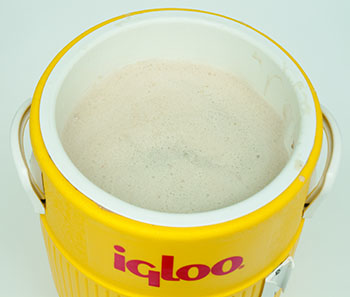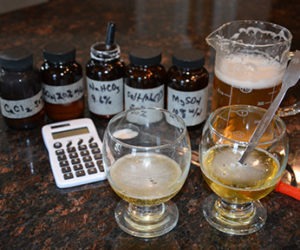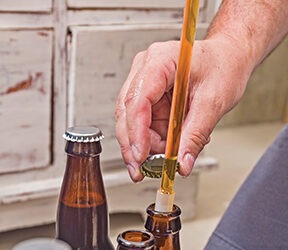Step Mashing Techniques

I am going to talk about step mashing and three particularly important rests, namely β-glucan, protein, and saccharification rests. If you are going to do a step mash you need to know why these are important (if indeed they are truly so) before setting out. I do not recommend doing such a mash just because you want to try it out, but rather because it suits the style of beer you want to brew, so do think carefully about that before jumping into this technique.
β-Glucan Rest
These compounds are not often mentioned in homebrewing circles, so a little explanation is in order here. Quite simply, β-glucans are a group of high molecular weight glucose polymers, with the “β”, beta, simply signifying the nature of the connection between the individual glucose units, something that doesn’t concern us here. These polymers occur in the cell walls of the barley grains and are mostly degraded during malting.
However, small amounts may survive into the finished malt and hence may dissolve in the wort during mashing. If they do so, since they are high molecular weight entities they can substantially increase wort viscosity, with the result that wort run-off from the spent grain will be very slow, as will filtration of the beer. That, of course, is a serious problem for commercial brewers who want to optimize their equipment usage by achieving as rapid a turnaround of mash or lauter tuns and filters as possible. It can, however, also be an inconvenience
for the homebrewer and result in the brew day being rather longer than it needs to be. A further problem that can occur with β-glucans is if they pass through to the finished beer, because they can precipitate from solution as a viscous, gelatinous mass, especially in stronger beers.
There are β-glucan-degrading enzymes in barley, and some of these usually survive after malting. Therefore, in mashing it is desirable to have a rest at a temperature at which these enzymes can do their work and degrade the β-glucans. Optimally, this is at 115–120 °F (46–49 °C). Below this range the reaction is much slower, while at higher temperatures the enzymes themselves are degraded before they get a chance to do their job.
In fact, the malts available to us today are generally well-modified and contain little in the way of β-glucans, so this temperature rest is not really necessary when brewing all-malt beers. If, however, you are using poorly-modified malt or other grain adjuncts such as oats, rye, and particularly raw barley, you should include this step to eliminate β-glucans.
Protein Rest
If you read about step mashing in any older literature you will come across the idea of a “protein rest” at 122 °F (50 °C). This is a historical construct in a sense, and is a notion that became established as a result of the use of under-modified malts in earlier times. It was regarded as essential in order to achieve good conversion of the starch and to break down high molecular weight proteins, so as to improve foam stability and prevent “chill hazes,” which are protein-tannin complexes that can form when the beer is cooled for serving. It was thought that protein degradation occurred in this step because research had shown the formation of what appeared to be the by-products of proteolytic processes, namely the formation of so-called free amino nitrogen. And so the name “protein rest” was given.
However, you will find that in modern literature, work has shown that the formation of this free amino nitrogen simply arises from the release of amino acids from the ends of the protein and polypeptide chains. In short, there is really no significant change in molecular weight of these species during this rest. Indeed, it is likely that there are no proteolytic enzymes present in malt and all the changes in molecular weight of barley proteins occurs during malting, not mashing. So, that means that it is not necessary to carry out a protein rest and that even this term is obsolete.
But, some brewers still insist on carrying out this rest believing that whatever chemistry goes on at this stage is helpful to foam formation and retention in the finished beer. During fermentation the presence of free amino nitrogen is essential for the yeast to produce a variety of products that affect the flavor and stability of the beer. So some brewers consider that using a rest like this to give the wort a little extra free amino nitrogen is worthwhile. My own take is that I have never found any advantage in using a rest at around 120 °F (49 °C), unless I was working with a poorly modified malt, such as raw wheat, rye malt, and so on where β-glucans might cause problems with wort run-off.
One further point about this is that a common way to raise mash temperature in a step process is to add enough hot water to the mash to bring it up to where you want it to be. If you use a lot of steps the amount of water you have to add can get out of hand and dilute the mash too much, so why do a step that doesn’t really do anything for you?
Saccharification Rests
The whole point of step mashing is to maximize the amount of extract you get from the malt and to obtain a wort with the kind of fermentability you want. What controls the latter are the enzymes, α- and β-amylase, which are the principle enzymes that break down starch into fermentable sugars and dextrins. Like all enzymes they are catalysts, which means they facilitate certain reactions. But they are very specific in their action and will normally only catalyze a specific reaction on a specific substrate — in our case starch, which is actually a mixture of two types of glucose polymer. β-amylase generally facilitates the breaking off of ends of the starch polymer chains so that it is largely responsible for the formation of fermentable sugars. On the other hand, α-amylase is effective in catalyzing the breaking of internal bonds in the starch molecule and so it is responsible for ensuring the complete breakdown of starch in the mash and the formation of dextrins (although it can produce some simple sugars like glucose and maltose).
What all that means is that the functions of these enzymes are complementary and both must work properly to obtain a wort of balanced composition. The first problem with this is that the optimum temperature range for each enzyme is different. The second problem is that the enzymes are degraded by heat, with β-amylase being much more temperature-sensitive than α-amylase. But the rate of enzymatic reaction increases with increasing temperature, so you have to run the mash reasonably hot so that these reactions go to completion in a reasonable time.
In infusion mashing the brewer makes a compromise and mashes at a single temperature, usually ±150 °F (65.6 °C), which is somewhere between the optimum values for each enzyme, 135–140 °F (57–60 °C) for β-amylase and about 158 °F (70 °C) for α-amylase. This means that the brewer’s control over wort fermentability and extract yield is somewhat limited compared to a step-temperature program. It is arguable that this is not a serious problem when brewing an ale with well-modified malts, but it is unarguable that step-mashing will produce a wort (and hence a beer) with different characteristics to that produced by infusion mashing. That is because you can actually carry out a mash with separate steps at the optimum temperature for each enzyme. In other words, you have much more control over extract yield and wort fermentability using this technique.
But are there disadvantages to step mashing? Of course there are, and the primary one is time. A typical mash time is about one hour. In step mashing each step takes 30–45 minutes, and extra time is required just to heat the mash to each step, so the whole procedure may take 2–3 hours.
How Do We Do a Step Mash?
This procedure became popular among commercial brewers with the advent of steam heated mash tuns, and that’s how it is mostly done today. But, of course, homebrewers are not likely to have steam heat, so that isn’t much help. Some of you may have a recirculating infusion mash system (RIMS) setup, although in this case you would more likely go for the so-called linear temperature program approach. That is, you would mash in at 135 °F (57 °C), then over a period of 60–90 minutes ramp up to 158 °F (70 °C), so that there is not an actual plateau step as such.
The more common and simpler approach for the homebrewer is to raise the mash temperature at each step by adding hot water, which should be as close to boiling as you can safely handle. You don’t want to finish with a very dilute mash as high dilution affects enzyme activity and will nullify the point of step mashing. Start with a fairly thick mash, say 0.8–1 qt./L of water per pound (0.45 kg) of grain, at 135 °F (57 °C) and let stand 30 minutes, during which time you prepare the hot water. Then add 2 qts./L of this with thorough mixing, check the temperature and repeat as necessary until you reach about 158 °F (70 °C). After 30–45 minutes you can mash out at 160–165 °F (71–74 °C) in the same way — it doesn’t matter about mash dilution at this stage as you are going to collect the wort immediately at this point. It is possible to calculate how much hot water to add, but that’s for a different column. You can also use trial and error and take notes of the volume added and the temperature reached at each addition for future reference.
Is it Worth it?
Step mashing is more complicated and time-consuming than infusion mashing, but it does give you more control over the finished product and will ensure good extract yields. Historically this procedure was mostly used for lager beers and infusion mashing for ales, but can be used for any style of beer. Whether the flavor of the resultant beer is any better with one procedure or another has not been proven (at least to my satisfaction), but you can try out the two methods for the same brew and decide for yourself.


